Related Research Articles

Charles Martin Jones was an American animator, painter, voice actor and filmmaker, best known for his work with Warner Bros. Cartoons on the Looney Tunes and Merrie Melodies series of shorts. He wrote, produced, and/or directed many classic animated cartoon shorts starring Bugs Bunny, Daffy Duck, Wile E. Coyote and the Road Runner, Pepé Le Pew, Marvin the Martian, and Porky Pig, among others.

Duck Amuck is an American animated surreal comedy short film directed by Chuck Jones and written by Michael Maltese. The short was released on January 17, 1953, as part of the Merrie Melodies series, and stars Daffy Duck.

What's Opera, Doc? is a 1957 American Warner Bros. Merrie Melodies cartoon directed by Chuck Jones and written by Michael Maltese. The short was released on July 6, 1957, and stars Bugs Bunny and Elmer Fudd.

Wile E. Coyote and the Road Runner are a duo of cartoon characters from the Looney Tunes and Merrie Melodies series of animated cartoons, first appearing in 1949 in the theatrical cartoon short Fast and Furry-ous. In each episode, the cunning, devious and constantly hungry coyote repeatedly attempts to catch and subsequently eat the roadrunner, but is always humorously unsuccessful in doing so. Instead of his instinctive animal abilities, the coyote uses absurdly complex contraptions to try to catch his prey. They comically backfire, with the coyote often getting injured in slapstick fashion. Many of the items for these contrivances are mail-ordered from a variety of companies implied to be part of the Acme Corporation. TV Guide included Wile E. Coyote in its 2013 list of "The 60 Nastiest Villains of All Time."
Charlie Dog is an animated cartoon character in the Warner Brothers Looney Tunes series of cartoons. The character was featured in nine cartoons between 1941 and 1958. He is generally characterized as a friendly wise guy.
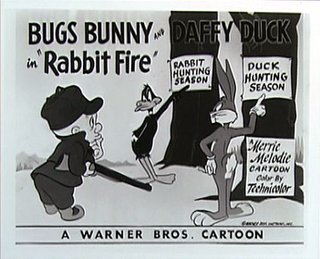
Rabbit Fire is a 1951 Looney Tunes cartoon starring Bugs Bunny, Daffy Duck, and Elmer Fudd. Directed by Chuck Jones and written by Michael Maltese, the cartoon is the first in Jones' "hunting trilogy"—the other two cartoons following it being Rabbit Seasoning and Duck! Rabbit, Duck! It is also the first cartoon to feature a feud between Bugs and Daffy. Produced by Edward Selzer for Warner Bros. Cartoons, the short was released to theaters on May 19, 1951 by Warner Bros. Pictures and is often considered among Jones' best and most important films.
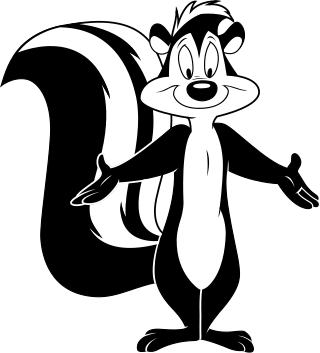
Pepé Le Pew is an animated character from the Warner Bros. Looney Tunes and Merrie Melodies series of cartoons, introduced in 1945. Depicted as a French anthropomorphic striped skunk, Pepé is constantly on the quest for love and pursuit of romance but typically his skunk odor cause other characters to run away from him.
Warner Bros. Cartoons, Inc. was an American animation studio, serving as the in-house animation division of Warner Bros. during the Golden Age of American animation. One of the most successful animation studios in American media history, it was primarily responsible for the Looney Tunes and Merrie Melodies series of animated short films. The characters featured in these cartoons, including Bugs Bunny, Daffy Duck, and Porky Pig, are among the most famous and recognizable characters in the world. Many of the creative staff members at the studio, including directors and animators such as Chuck Jones, Friz Freleng, Robert McKimson, Tex Avery, Robert Clampett, Arthur Davis, and Frank Tashlin, are considered major figures in the art and history of traditional animation.
Bully for Bugs is a 1953 Warner Bros. Looney Tunes theatrical cartoon short directed by Chuck Jones and written by Michael Maltese. The cartoon was released on August 8, 1953, and stars Bugs Bunny.
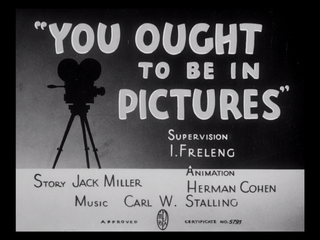
You Ought to Be in Pictures is a 1940 Warner Bros. Looney Tunes short film directed by Friz Freleng. The cartoon was released on May 18, 1940, and stars Porky Pig and Daffy Duck.

Frigid Hare is a Warner Bros. Merrie Melodies short, released on October 8, 1949. It is directed by Chuck Jones and written by Michael Maltese, and features Bugs Bunny. The title can be seen as a simple play on "frigid air" and/or on the refrigerator brand called "Frigidaire".

For Scent-imental Reasons is a 1949 Warner Bros. Looney Tunes short directed by Chuck Jones and written by Michael Maltese. The short was released on November 12, 1949, and featured the debut of Penelope Pussycat.

Transylvania 6-5000 (1963) is a Warner Bros. Merrie Melodies animated short directed by Chuck Jones. The short was released on November 30, 1963, and stars Bugs Bunny.

Deduce, You Say is a 1956 Warner Bros. Looney Tunes cartoon, directed by Chuck Jones and written by Michael Maltese. The short was released on September 29, 1956, and stars Daffy Duck and Porky Pig. The title is a play on the exclamation, "The deuce, you say!"

A Sheep in the Deep is a 1962 Warner Bros. Merrie Melodies cartoon directed by Chuck Jones and Maurice Noble. The short was released on February 10, 1962, and stars Ralph Wolf and Sam Sheepdog.

Rabbit's Feat is an animated 1960 Warner Bros. Looney Tunes cartoon, directed by Chuck Jones and written by Michael Maltese. The short was released on June 4, 1960, and stars Bugs Bunny and Wile E. Coyote. As Maltese had left for Hanna-Barbera, his name was removed from the credits.

Ralph Wolf and Sam Sheepdog are characters in a series of animated cartoons in the Warner Bros. Looney Tunes and Merrie Melodies cartoons. The characters were created by Chuck Jones.
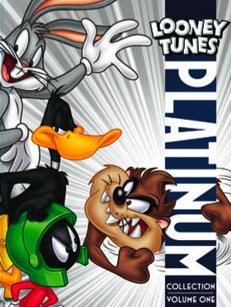
Looney Tunes Platinum Collection: Volume 1 is a Blu-ray Disc and DVD box set by Warner Home Video. It was released on November 15, 2011. It contains 50 Looney Tunes and Merrie Melodies cartoons and numerous supplements. A DVD version of the box set was released on July 3, 2012, but contained no extras.
Boyhood Daze is a 1957 Warner Bros. Merrie Melodies cartoon directed by Chuck Jones. The script was written by Michael Maltese, and the film score was composed by Milt Franklyn. The film was produced by Edward Selzer. The voices were provided by Dick Beals, Daws Butler and Marian Richman. It contains the science fiction element of an alien invasion.
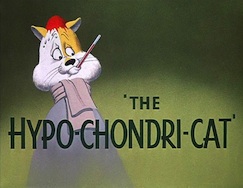
The Hypo-Chondri-Cat is a 1950 Warner Bros. Merrie Melodies short directed by Chuck Jones and written by Michael Maltese. The cartoon was released on April 15, 1950 and stars Hubie and Bertie and Claude Cat. The title is a play on "hypochondriac".
References
- ↑ Beck, Jerry; Friedwald, Will (1989). Looney Tunes and Merrie Melodies: A Complete Illustrated Guide to the Warner Bros. Cartoons. Henry Holt and Co. p. 266. ISBN 0-8050-0894-2.
- ↑ Lenburg, Jeff (1999). The Encyclopedia of Animated Cartoons. Checkmark Books. pp. 100–102. ISBN 0-8160-3831-7 . Retrieved 6 June 2020.
- 1 2 3 4 "From A to Z-Z-Z-Z". BCDB.com. Retrieved August 17, 2012.[ dead link ]
- 1 2 Ralph Phillips at Don Markstein's Toonopedia. Archived from the original on November 4, 2016.
- 1 2 Beck, Jerry, ed. (2020). The 100 Greatest Looney Tunes Cartoons. Insight Editions. pp. 2–3. ISBN 978-1-64722-137-9.